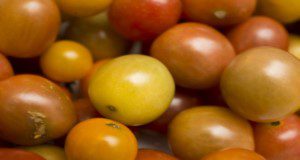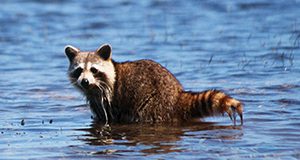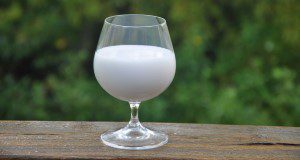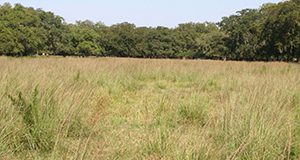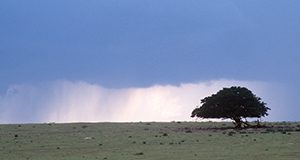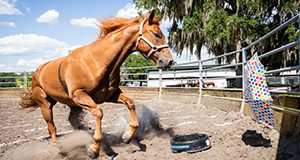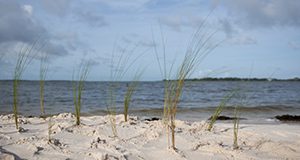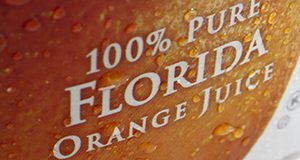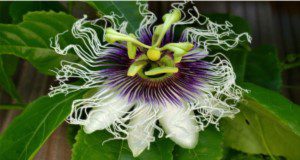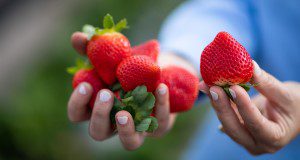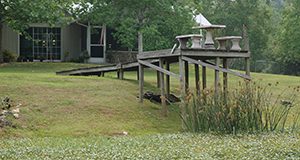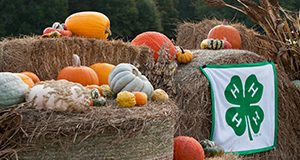Herbicide resistance was historically not a significant issue in most horticultural crops because few herbicides were applied. Close proximity of agronomic crops and the loss of methyl bromide has led to a gradual increase in herbicide inputs and the increased occurrence of herbicide-resistant weeds in tomato fields. Very few herbicides are registered for tomato, and resistance is a major concern. This new 11-page publication of the UF/IFAS Horticultural Sciences Department provides a definition of herbicide resistance, explains how it develops, and provides management recommendations for tomato growers. It was written for growers and Extension agents, but the information may be of interest to anyone concerned about herbicide resistance in vegetable and small fruit crops. Written by Shaun M. Sharpe, Nathan S. Boyd, Ramdas G. Kanissery, and Peter J. Dittmar.
https://edis.ifas.ufl.edu/hs1398
Facts about Wildlife Diseases: Raccoon-Borne Pathogens of Importance to Humans—The Raccoon Roundworm
Diseases carried by northern raccoons present significant health hazards to both people and pets. This 7-page fact sheet written by Caitlin Jarvis and Mathieu Basille and published by the UF/IFAS Department of Wildlife Ecology and Conservation is part of a series addressing health hazards associated with raccoons. It describes the raccoon roundworm and the disease it causes, baylisascariasis, which normally causes little or no trouble to raccoons but in severe cases can make people and their pets very sick. Sick wild animals can act tame, but do not approach! Contact animal control or a wildlife rehabilitator if an animal seems to be behaving abnormally or if you suspect it is sick.
https://edis.ifas.ufl.edu/uw480
Facts about Wildlife Diseases: Raccoon-Borne Pathogens of Importance to Humans—Parasites
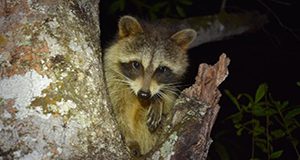
Diseases carried by northern raccoons present significant health hazards to both people and pets. This 7-page fact sheet written by Caitlin Jarvis and Mathieu Basille and published by the UF/IFAS Department of Wildlife Ecology and Conservation is part of a series addressing health hazards associated with raccoons. It describes the most important internal and external parasites associated with raccoons. Sick wild animals can act tame, but do not approach! Contact animal control or a wildlife rehabilitator if an animal seems to be behaving abnormally or if you suspect it is sick.
https://edis.ifas.ufl.edu/uw479
Facts about Wildlife Diseases: Raccoon-Borne Pathogens of Importance to Humans—Viruses and Bacteria
Diseases carried by northern raccoons present significant health hazards to both people and pets. This 7-page fact sheet written by Caitlin Jarvis, Samantha M. Wisely, and Mathieu Basille and published by the UF/IFAS Department of Wildlife Ecology and Conservation is part of a series addressing health hazards associated with raccoons. It describes rabies, canine distemper, feline distemper, canine parvovirus, salmonellosis, and several other raccoon-borne viral and bacterial diseases of concern to people and their pets. Sick wild animals can act tame, but do not approach! Contact animal control or a wildlife rehabilitator if an animal seems to be behaving abnormally or if you suspect it is sick.
https://edis.ifas.ufl.edu/uw478
Leches a base de plantas: Coco
La leche de coco es una de las muchas variedades de alternativas vegetales a la leche de vaca. Los factores que pueden llevar a los consumidores hacia alternativas a la leche no láctea incluyen la adherencia a una dieta vegana, la intolerancia a la lactosa, la alergia a la leche de vaca o simplemente la preferencia. El propósito de esta guía es informarle sobre el contenido de nutrientes de la leche de coco y sus posibles beneficios y riesgos para la salud.
This new 4-page article is the Spanish language version of FSHN20-49/FS411, Plant-Based Milks: Coconut, written by Celia Andreo, Daniela Rivero-Mendoza, and Wendy J Dahl, and published by the UF/IFAS Food Science and Human Nutrition Department.
https://edis.ifas.ufl.edu/fs421
The Road to Recovery: Building Physical and Emotional Trust when Engaging with Extension Clientele
Now is a crucial time for Extension professionals to engage with clientele. In both urban and rural communities, clients are facing a multitude of unprecedented challenges related to COVID-19. Many Extension professionals already have experience in emergency and disaster preparedness, response, and recovery that can be applied in the present context. However, we must rethink how we interact with and assist clientele to ensure their safety and our own. To do this, it is critical we understand that the pandemic has exacerbated emotional trauma and anxiety resulting in trust gaps. This new 4-page publication of the UF/IFAS Department of Agricultural Education and Communication aims to build Extension professionals’ sensitivity to the needs and emotional strains that COVID-19 presents for clients, and the strategies needed for effective recovery. Written by Colby Silvert, Cody Gusto, and John Diaz.
https://edis.ifas.ufl.edu/wc376
Smutgrass Control in Perennial Grass Pastures
This 4-page document provides an overview of smutgrass biology, control, and general recommendations. Written by Brent Sellers, Neha Rana, José Luiz C. S. Dias, and Pratap Devkota, and published by the UF/IFAS Agronomy Department, revised October 2020.
https://edis.ifas.ufl.edu/aa261
Chilli Thrips on Blueberries in Florida
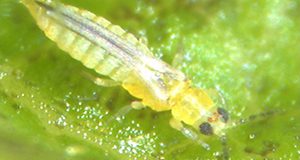
Chilli thrips, (Scirtothrips dorsalis Hood; Thysanoptera: Thripidae), is an economically important pest of vegetable, fruit, and ornamental crops throughout Asia, Africa, Oceania, the Caribbean, and some parts of South America and is an invasive pest in several US states. Chilli thrips were first observed in Florida in 1991. It was first recorded in blueberries in Hernando, Pasco and Sumter counties in July of 2008. This 4-page fact sheet written by Oscar E. Liburd, Babu R. Panthi, and Douglas A. Phillips and published by the UF/IFAS Entomology and Nematology Department discusses the life cycle of the chilli thrips, plant damage it causes, and management recommendations for chilli thrips in blueberries in Florida.
https://edis.ifas.ufl.edu/in1298
How Are Our Future Agriculture and Natural Resources Projected under Varying Climate?
This 8-page article explains how agriculture and natural resources may respond to projected future climate and how climate projections can be useful in developing management plans for the improved sustainability of Florida's agriculture and natural resources. It also aims to help increase the public awareness of climate change impacts on Florida and improve understanding of the connections among climate, agriculture, and natural resources. Written by Young Gu Her, Ashley Smyth, Zachary Brym, and Elias Bassil, and published by the UF/IFAS Department of Agricultural and Biological Engineering, September 2020.
https://edis.ifas.ufl.edu/ae545
Anhidrosis in the Horse (Non-Sweaters)—What Do We Know?
This 3-page document provides an overview of anhidrosis in horses, including symptoms and management tips. Written by Laura Patterson-Rosa, Martha F. Mallicote, Robert J. MacKay, and Samantha A. Brooks, and published by the UF/IFAS Department of Animal Sciences, October 2020.
https://edis.ifas.ufl.edu/an362
Online Sources for Sea Level Rise Education and Extension
The impacts of sea level rise on ecosystems and natural resources are a major concern in Florida, especially in low-lying coastal areas such as south Florida. Sea level rise can impact many aspects of Florida's economy, including urban development, agriculture, infrastructure, and natural areas. This 16-page document introduces, evaluates, and summarizes selected available online sources and tools to educate diverse stakeholders and concerned local residents on important aspects of sea level rise. Written by Young Gu Her, Ashley Smyth, Jiangxiao Qiu, Elias Bassil, Ulrich Stingl, and Laura Reynolds, and published by the UF/IFAS Department of Agricultural and Biological Engineering, June 2020.
https://edis.ifas.ufl.edu/ae543
Do Millennials Have a Stronger Demand for Orange Juice?
Accounting for a quarter of the population in the United States, the millennial generation is believed to have stronger buying power than other generations. But does targeting orange juice marketing to millennials, and, in particular, millennial parents, reap rewards? This 4-page fact sheet written by Yan Heng, Ronald W. Ward, and Lisa A. House and published by the UF/IFAS Food and Resource Economics Department presents the results of a survey examining several generations and their impact on demand for orange juice to find out whether targeting this one is a wise marketing strategy.
https://edis.ifas.ufl.edu/fe1089
Passion Fruit Problems in the Home Landscape
In Florida, purple and yellow passion fruit have been widely cultivated by homeowners for years, and south Florida’s subtropical climate allows for growing passion fruit year-round. Many factors affect longevity and productivity of passion fruit vine, including environmental stresses, pests, and disease. This new 5-page document is designed to help Master Gardeners and homeowners by answering commonly asked questions about passion fruit production problems. Written by Amir Rezazadeh, Mark Bailey, and Ali Sarkhosh, and published by the UF/IFAS Horticultural Sciences Department.
https://edis.ifas.ufl.edu/hs1397
Leaf Spot Diseases of Strawberry
Several different fungi and one bacterium cause leaf spot diseases of Florida strawberry. Symptoms caused by these pathogens are often similar, leading to confusion and misdiagnosis of the disease. To facilitate diagnosis, the most common leaf spots diseases of strawberry in Florida are described in this new 6-page article, written by Juliana S. Baggio, James C. Mertely, and Natalia A. Peres, and published by the UF/IFAS Plant Pathology Department.
https://edis.ifas.ufl.edu/pp359
Facilitating Community Change: Lessons from Climate Adaptation to Guide Extension Engagement
This 19-page publication written by Martha Monroe and Annie Oxarart and published by the UF/IFAS School of Forest Resources and Conservation provides Extension faculty in Florida with useful strategies to help communities understand, discuss, evaluate, and recommend potential solutions to current and future problems. While much of the research behind these strategies has been conducted in the context of climate adaptations in vulnerable communities and ecosystems, such as coastal fisheries, rainfed agriculture, and floodplain cities, the principles that underlie these processes are universal. The same strategies and guidelines can be tailored for any issue that requires the public to become more informed, generate options, and understand advantages and disadvantages of various choices. In these situations, Extension agents can facilitate a process of thoughtful deliberation to help communities find common ground and move toward finding solutions.
https://edis.ifas.ufl.edu/fr430
Constructing a Southwest Florida Bell Peppers Enterprise Budget
Enterprise budgets can assist with forecasting as well as help managers coordinate resources, make production decisions, examine expenditures, and anticipate outcomes from changes in production practices. They can help producers determine what to produce, how many acres to produce, the cost of production, and the necessary price to be profitable. This 6-page fact sheet written by Tara Wade, Barbara Hyman, and Eugene McAvoy and published by the UF/IFAS Food and Resource Economics Department describes the process used to create the 2018-19 enterprise budget for bell peppers in southwest Florida.
https://edis.ifas.ufl.edu/fe1088
Applications of Unmanned Aerial Systems in Agricultural Operation Management: Part I: Overview
Unmanned aerial systems (UASs, UAVs, or drones) have emerged as one of the most promising technologies for agricultural operation management in recent decades. This 6-page publication provides an overview of the broad areas where UASs can be utilized for monitoring and managing farm operations. Written by James Fletcher and Aditya Singh, and published by the UF/IFAS Department of Agricultural and Biological Engineering, June 2020.
https://edis.ifas.ufl.edu/ae541
The Pear (Pyrus spp.) in Florida Home Gardens
Pears are a great tree to grow for an edible landscape or fruit garden. However, pears are not adapted to all areas in Florida, and only a few cultivated varieties will grow well here. An adaptation to warm winters (low chill hours) and disease resistance are the main factors for success. This new 6-page publication of the UF/IFAS Horticultural Sciences Department provides information to help homeowners select and grow pears successfully in Florida. Written by Juanita Popenoe, Ali Sarkhosh, and Dustin Huff.
https://edis.ifas.ufl.edu/hs1393
Cooperative Unit Systems: 3. Swine Facilities
Facilities are one of the most important considerations for housing market swine projects in groups. This 5-page document discusses basic facilities requirements, weather protection, spacing requirements, penning arrangements, and fencing materials. Written by Alyssa Schortinghouse, and published by the UF/IFAS 4-H Youth Development Department, September 2020.
https://edis.ifas.ufl.edu/4h410
A Simple, Inexpensive, and Portable Image-Based Technique for Nondestructive Leaf Area Measurements
This new 6-page article, part of a series introducing various image-based measurements for horticultural research, introduces a simple, inexpensive, and portable image-based technique for nondestructive leaf area measurements. It uses an imaging apparatus made with ordinary office supplies to obtain leaf images in greenhouse or field environments. Leaf images are then processed and analyzed to measure leaf area using ImageJ, an open-source image processing program. Because both image capture and analysis are performed nondestructively, leaf area can be measured on the same leaf repeatedly, enabling the monitoring of leaf growth over time, as well as photosynthesis and transpiration. This technique is particularly useful to researchers and students studying leaf growth and physiology in greenhouse or field environments. Written by Shinsuke Agehara, Lillian Pride, Mariel Gallardo, and Jose Hernandez-Monterroza, and published by the UF/IFAS Horticultural Sciences Department.
https://edis.ifas.ufl.edu/hs1395
